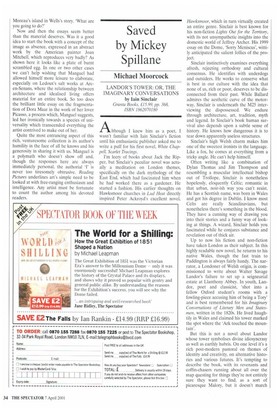A richly personal matter
Jonathan Keates
READING PICTURES: A HISTORY OF LOVE AND HATE by Alberto Manguel Bloomsbury, £30, pp. 337, ISBN 0747552959 The title of this book is likely to provoke outrage in a certain sort of art enthusiast. I mean the type of gallery visitor who, probably, as a reaction to connoisseurs and scholars, believes that interpretation equals violation, that a picture is essentially raped when we begin seeking for significance within the image rather than remaining comfortable inside the boundaries created by an immediate visual response. For such people 'art's all about fine fillin's', as Frederick Delius used to say when asked to explain his music, and woe betide those who scrutinise it too narrowly.
Alberto Manguel is having none of this. For him a personal response to painting, sculpture and architecture is not simply a matter of planting oneself in front of the relevant art object and inhaling its essence, a species of aesthetic substance-abuse producing the same nonspecific exhilaration as a well-rolled joint or a line of coke. To look at a picture is 'to tease the story out of an image', constructing our narrative 'through gossip, reverie, prejudice, illumination, scruples, ingenuity, compassion, wit', as well as a vast range of private cir
cumstances and intimate associations.
Reading Pictures is thus a highly individual account of one writer's visual experience. The works Manguel chooses are not necessarily landmarks in the traditional canon. Picasso and Caravaggio may get a look-in, but otherwise this is emphatically not the art-history slide-lecture on masterpieces in world art. The writer is one of those rare souls whose eclectic, omnivorous curiosity leaves them unimpressed by the laziness of critical orthodoxy, preferring to trust instead to their own adventurous instincts in forming a personal taste. Thus in place of Michelangelo or Rodin, he offers us the 18th-century Brazilian sculptor Aleijadinho, 'little cripple', the handicapped son of an African slave and a Portuguese architect, whose life-size Passion scenes in the pilgrimage church of Congonhas are all the more powerful for the qualities of suppressed rage and yearning which inspire them. In Renaissance Flanders, as an alternative to Meinling and Van Eyck, we are presented with an anonymous 'Virgin and Child before a Firescreen'. The Madonna may look like what the Victorians called 'the horse's godmother', with her puffy cheeks and nose like an airport runway, and infant Jesus may seem profoundly unenthused by the milk-heavy dug she proffers for his nourishment, but out of both these images Manguel spins a wondrous nexus of cross-reference, allusion, echo and counter-echo.
The scene, through his reading of it, breaks into two distinct paintings, one purveying a comfortable domesticity, with its solid oak bench, painted floorboards, a book left open on a crumpled cushion, a bright flame leaping up behind the firescreen and one of those miniature perspective landscapes viewed through an open window which form the calling-card of Flemish artists. Side by side with all this lies an essay in theology, complex and infinite, revealed in details such as the Virgin's wedding ring (she is God's wife as much as Joseph's), Christ's uncircumcised penis, only recently disclosed under some prudish 19th-century overpainting, the three-legged stool symbolising the Trinity and the screen as a halo lit by the fire of the Holy Ghost.
Elsewhere in this select gallery it is a question of the picture examining the reader rather than vice versa. Lavinia Fontana, a 16th-century Bolognese artist of fairly modest talents, initially shocks us with her portrait of Antonia Gonzalez, `Tognina', who had inherited from her father the excessive hairiness known as hypertrichosis universalis, and was passed to and fro between Habsburg and Farnese courts as a treasured freak of nature. Is this inherently a self-portrait, its deliberately confrontational frankness embodying Fontana's own audacity in attempting what only men were supposed to be good at? 'Here I am,' says the feral face above the bejewelled bodice and satin skirts, like a creature from Dr Moreau's island in Wells's story. 'What are you going to do?'
Now and then the essays seem better than the material deserves. Was it a good idea to start the book with a concept of the image as absence, expressed in an abstract work by the American painter Joan Mitchell, which reproduces very badly? As shown here it looks like a plate of burnt scrambled egg. In one or two other cases we can't help wishing that Manguel had allowed himself more leisure to elaborate, especially on Ledoux's salt works at Arcen-Senans, where the relationship between architecture and idealised living offers material for an entire book. So too does the brilliant little essay on the fragmentation of Dora Maar in the work of her lover Picasso, a process which, Manguel suggests, led her ironically towards a species of universality which transcended everything the artist contrived to make out of her.
Quite the most entrancing aspect of this rich, venturesome collection is its author's humility in the face of all he knows and his generosity in sharing it with us. Manguel is a polymath who doesn't show off and, though the responses here are always immediately personal, the authorial T is never too tiresomely obtrusive. Reading Pictures underlines art's simple need to be looked at with free-ranging enthusiasm and intelligence. Any artist must be fortunate to count the author among his devoted readers,



























































 Previous page
Previous page